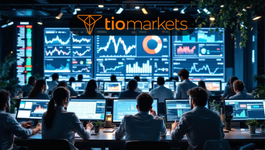What is Trading?
BY TIOmarkets
|May 14, 2024Trading is a fundamental activity that has been around for centuries. It plays a crucial role in the global economy, allowing individuals and businesses to exchange goods, services, and financial instruments. In this article, we will delve into the world of trading, exploring its definition, history, basic concepts, different types, and much more. So, let's dive in and discover the exciting world of trading!
Introduction to Trading
Trading has always been an essential part of human society. From ancient times, people have engaged in trading to acquire goods and services they needed but couldn't produce themselves. Today, trading has evolved into a complex system that goes far beyond bartering.
With the advancement of technology, people can now trade various assets such as stocks, commodities, currencies, and more through platforms known as exchanges. These exchanges facilitate buying and selling, creating a marketplace where buyers and sellers interact.
One of the key aspects of trading is the concept of supply and demand. Prices of assets fluctuate based on the balance between supply and demand in the market. When there is high demand for a particular asset and limited supply, its price tends to increase. Conversely, when there is an oversupply of an asset and low demand, its price may decrease.
Traders employ various strategies to capitalize on these price movements. Some traders focus on technical analysis, using historical price data and charts to predict future price movements. Others rely on fundamental analysis, which involves evaluating the financial health and performance of companies to make trading decisions.
Definition of Trading
Trading can be defined as the process of buying and selling financial instruments or goods with the intention of making a profit. It involves speculating on the future price movements of assets and making informed decisions to maximize gains and minimize losses.
Traders, whether individuals or institutions, analyze market trends, economic indicators, and other relevant factors to make well-informed trading decisions. This requires a deep understanding of the market dynamics and the ability to make quick and strategic moves.
Successful trading often involves a combination of technical analysis, which focuses on historical price data and chart patterns, and fundamental analysis, which considers economic and financial factors that may influence asset prices. Traders may also use various tools and strategies such as moving averages, Fibonacci retracements, and support and resistance levels to identify potential entry and exit points.
Furthermore, trading can take place in various financial markets, including stocks, bonds, commodities, foreign exchange, and cryptocurrencies. Each market has its unique characteristics and factors that influence price movements, requiring traders to adapt their strategies accordingly.
History of Trading
The roots of trading can be traced back to ancient civilizations, where people used barter systems to exchange goods. As societies advanced, trading evolved, with the introduction of currencies and formal marketplaces.
In the 17th century, the world witnessed the birth of stock markets, such as the London Stock Exchange. This marked a significant milestone in the history of trading, as it allowed individuals to invest in companies and share in their profits.
With the advent of the internet, online trading became accessible to the masses, revolutionizing the way people trade. Today, trading has become a global phenomenon, connecting traders from all corners of the world.
Understanding the Basics of Trading
Before delving deeper into the intricate world of trading, it's essential to grasp some basic concepts. Two fundamental elements of trading are buyers and sellers. Buyers, also known as bulls, aim to profit from rising prices, while sellers, also known as bears, aim to profit from falling prices.
Another essential factor to understand in trading is the concept of supply and demand. When demand for a particular asset exceeds supply, its price tends to rise, and when supply surpasses demand, its price tends to fall.
Furthermore, it's crucial to be aware of the role that emotions and psychology play in trading. Fear and greed can cloud judgment and lead to irrational decisions. Successful traders develop discipline and emotional control to navigate the ups and downs of the market.
How Trading Works
The mechanics of trading vary depending on the asset class being traded. In financial markets, including stocks, bonds, and commodities, trading typically occurs on exchanges. These exchanges provide a platform for buyers and sellers to meet and execute trades.
When a buyer and seller agree on a price, a trade is executed. The exchange matches the buy and sell orders, ensuring a fair and transparent process. The price of an asset is determined by various factors, including supply and demand, news events, economic data, and investor sentiment.
Key Concepts in Trading
Successful trading requires understanding several key concepts. One important aspect is technical analysis, which involves studying historical price patterns, charts, and indicators to predict future price movements.
Another critical concept is fundamental analysis, which involves assessing the intrinsic value of an asset by analyzing economic factors, company financials, and industry trends.
Risk management is also vital in trading. Traders employ various strategies, such as setting stop-loss orders, diversifying their portfolios, and managing position sizes, to limit potential losses and protect their capital.
Types of Trading Markets
Trading markets can be broadly categorized into three main types: equity markets, commodity markets, and foreign exchange markets (forex). Each market has its characteristics and offers unique opportunities for traders.
Equity markets involve trading stocks, representing ownership in publicly traded companies. Commodity markets, on the other hand, deal with trading physical goods, such as crude oil, gold, and agricultural products. Forex markets focus on trading currencies, providing opportunities for traders to speculate on exchange rate fluctuations.
Financial Instruments in Trading
Trading offers a wide range of financial instruments to trade, catering to different risk appetites and investment goals. Some common financial instruments include stocks, bonds, options, futures, and exchange-traded funds (ETFs).
Each of these instruments has its characteristics, benefits, and associated risks. For instance, stocks offer ownership in a company and the potential for capital appreciation, while bonds provide fixed interest payments.
Types of Trading
Trading can be classified into several types, depending on the timeframe and strategies employed. Day trading involves buying and selling assets within a single trading day, aiming to profit from short-term price fluctuations.
Swing trading, on the other hand, involves holding assets for a few days to weeks, taking advantage of medium-term trends. Long-term investing focuses on holding assets for an extended period, usually years, in anticipation of significant price appreciation.
Trading Methods and Strategies
Successful traders employ various methods and strategies to maximize their profits. These strategies can be based on technical analysis, fundamental analysis, or a combination of both.
Some popular trading strategies include trend following, where traders identify and take advantage of price trends, and breakout trading, where traders enter positions when an asset breaks through significant support or resistance levels.
Other strategies include mean reversion, where traders bet that the price of an asset will return to its average value after deviating, and scalping, where traders make small profits from frequent trades.
Risk Management in Trading
Risk management is a crucial aspect of trading and involves assessing and mitigating potential risks. Traders use various tools and techniques to manage risk, such as setting stop-loss orders to limit losses if a trade goes against them.
Diversification is another risk management technique that involves spreading investments across different assets to reduce exposure to any single investment. Additionally, traders should have a clear understanding of their risk tolerance and only risk a portion of their capital that they can afford to lose.
Benefits of Trading
Trading offers several benefits for individuals and institutions alike. For individuals, trading provides the opportunity to generate additional income, build wealth, and achieve financial independence.
Furthermore, trading can be flexible, allowing traders to participate from anywhere in the world with an internet connection. Traders can also choose their trading style, time commitment, and financial goals, providing a high degree of personal autonomy.
Risks of Trading
Trading also comes with inherent risks that traders must be aware of. The most apparent risk is the potential loss of invested capital. Prices can be volatile and unpredictable, leading to significant losses if not managed properly.
Moreover, trading requires continuous learning and staying updated with market trends and news. Failing to adapt to changing market conditions can result in missed opportunities and losses.
Getting Started with Trading
If you're interested in venturing into the world of trading, there are several steps you can take to get started. First, educate yourself about different asset classes and trading strategies.
Open a brokerage account with a reputable broker that offers access to the markets you're interested in trading. Practice trading with virtual money through a demo account to gain experience and test your strategies.
As you become more comfortable and confident, you can start trading with real money, but always remember to start small and gradually increase your position sizes.
Conclusion
In conclusion, trading is a dynamic and exciting endeavor that has evolved over time. It offers individuals and businesses the opportunity to profit from market movements, whether through stocks, commodities, or currencies.
However, it's important to approach trading with caution and a well-thought-out plan. Successful trading requires knowledge, discipline, and a thorough understanding of the market dynamics. So, if you're ready to embark on this thrilling journey, start by educating yourself and practicing on a demo account. Happy trading!
Start Your Trading Journey with TIOMarkets
Ready to put your trading knowledge into action? Join over 170,000 traders in 170 countries who have chosen TIOMarkets as their trusted forex broker. With our platform, you can trade over 300 instruments across 5 markets, including Forex, indices, stocks, commodities, and futures, all with low fees. Plus, enhance your trading skills with our comprehensive educational resources and step-by-step guides. Don't wait any longer to embark on your trading adventure.
Create a Trading Account today and start trading the smart way with TIOMarkets!

Risk disclaimer: CFDs are complex instruments and come with a high risk of losing money rapidly due to leverage. You should consider whether you understand how CFDs work and whether you can afford to take the high risk of losing your money. Never deposit more than you are prepared to lose. Professional client’s losses can exceed their deposit. Please see our risk warning policy and seek independent professional advice if you do not fully understand. This information is not directed or intended for distribution to or use by residents of certain countries/jurisdictions including, but not limited to, USA & OFAC. The Company holds the right to alter the aforementioned list of countries at its own discretion.
Join us on social media

Behind every blog post lies the combined experience of the people working at TIOmarkets. We are a team of dedicated industry professionals and financial markets enthusiasts committed to providing you with trading education and financial markets commentary. Our goal is to help empower you with the knowledge you need to trade in the markets effectively.
Related Posts





